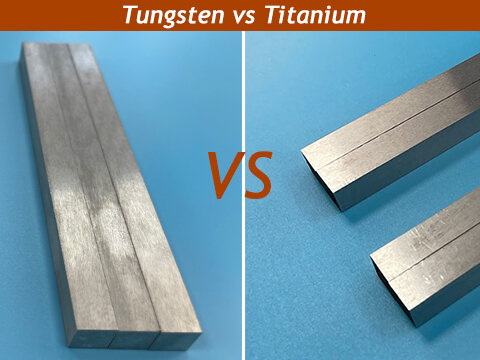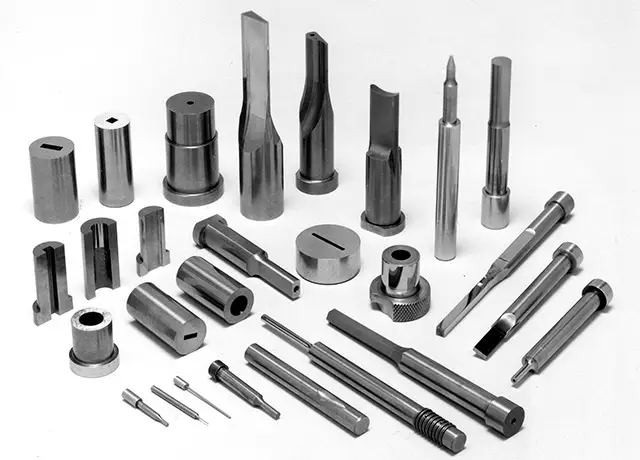Content Menu
● Introduction to Titanium and Tungsten Carbide
>> Titanium
>> Tungsten Carbide
● Comparison of Strength and Durability
>> Hardness
>> Tensile Strength
>> Density and Weight
● Applications
>> Aerospace and Medical
>> Industrial and Machining
>> Jewelry and Consumer Products
● Environmental and Cost Considerations
>> Environmental Impact
>> Cost Comparison
● Future Developments
● Conclusion
● Frequently Asked Questions
>> 1. What is the primary difference in hardness between titanium and tungsten carbide?
>> 2. Which material is more suitable for aerospace applications?
>> 3. What are the typical applications of tungsten carbide?
>> 4. Is tungsten carbide more brittle than titanium?
>> 5. Which material is more hypoallergenic for jewelry?
● Citations:
When comparing titanium and tungsten carbide, it's essential to understand their unique properties and how they apply to different applications. Both materials are renowned for their strength and durability, but they serve distinct purposes based on their hardness, density, and tensile strength.

Introduction to Titanium and Tungsten Carbide
Titanium
Titanium is a lightweight metal known for its high strength-to-weight ratio, corrosion resistance, and good heat resistance. It is widely used in aerospace, medical implants, and high-performance sports equipment due to its ability to maintain strength while being significantly lighter than steel.
Key Properties of Titanium:
- Density: Approximately 4.5 g/cm³.
- Melting Point: Around 3,034°F (1,668°C).
- Tensile Strength: Typically ranges from 240 MPa to over 1,000 MPa depending on the alloy.
- Hardness: Moderately hard with a Mohs hardness of about 6.
Titanium's corrosion resistance is also noteworthy, making it suitable for marine environments and medical implants where biocompatibility is crucial. Its ability to withstand extreme temperatures without losing strength is another reason it's favored in aerospace applications.
Tungsten Carbide
Tungsten carbide is a compound made from tungsten and carbon, known for its exceptional hardness and wear resistance. It is commonly used in cutting tools, mining equipment, and other heavy-duty industrial applications.
Key Properties of Tungsten Carbide:
- Density: Approximately 15.6-15.8 g/cm³.
- Melting Point: Around 5,200°F (2,870°C).
- Tensile Strength: Generally lower than pure tungsten, around 344.8 MPa.
- Hardness: Extremely hard with a Mohs hardness of about 9.
Tungsten carbide's hardness makes it ideal for applications requiring high scratch resistance and durability. However, its brittleness can be a drawback, as it may crack under impact.
Comparison of Strength and Durability
Hardness
Tungsten carbide is significantly harder than titanium, with a Mohs hardness of 9 compared to titanium's 6. This makes tungsten carbide ideal for applications requiring high scratch resistance and wear durability, such as cutting tools and industrial machinery.
Tensile Strength
Titanium generally offers higher tensile strength than tungsten carbide, especially when considering its strength-to-weight ratio. Titanium's tensile strength can range from 240 MPa to over 1,000 MPa depending on the alloy, while tungsten carbide's tensile strength is typically around 344.8 MPa.
Density and Weight
Tungsten carbide is much denser than titanium, with a density of approximately 15.6-15.8 g/cm³ compared to titanium's 4.5 g/cm³. This makes tungsten carbide heavier and more suitable for applications where weight is not a concern but high strength and durability are crucial.

Applications
Aerospace and Medical
Titanium is favored in aerospace and medical applications due to its lightweight nature and high strength-to-weight ratio. It is used in aircraft frames, medical implants, and other components where weight reduction is critical without compromising strength. In medical implants, titanium's biocompatibility and corrosion resistance ensure safety and longevity.
Industrial and Machining
Tungsten carbide is ideal for industrial machining and cutting tools due to its exceptional hardness and wear resistance. It is used in drill bits, saw blades, and other heavy-duty machinery where durability and scratch resistance are paramount. The high melting point of tungsten carbide also makes it suitable for high-speed cutting operations.
Jewelry and Consumer Products
In jewelry, both titanium and tungsten carbide are used for rings due to their durability. Tungsten carbide rings are more scratch-resistant but can be brittle and crack under impact. Titanium rings are lighter and less likely to crack, making them suitable for those who prefer comfort and durability without the risk of cracking. Additionally, titanium is often hypoallergenic, making it a better choice for individuals with sensitive skin.
Environmental and Cost Considerations
Environmental Impact
Titanium and tungsten carbide have different environmental impacts. Titanium is generally more environmentally friendly due to its recyclability and lower toxicity. Tungsten carbide, while durable, involves more complex recycling processes and may have higher environmental costs associated with its production.
Cost Comparison
Tungsten carbide is generally more expensive than titanium due to the complexity of its production process and the high cost of tungsten. However, the exceptional durability of tungsten carbide can offset its higher upfront cost in long-term industrial applications.
Future Developments
Both titanium and tungsten carbide are being researched for new applications. Titanium alloys are being developed for improved strength and corrosion resistance, while tungsten carbide is being explored for advanced cutting tools and wear-resistant coatings. The integration of these materials into emerging technologies, such as renewable energy systems and advanced manufacturing, is expected to drive innovation in various sectors.
Conclusion
In conclusion, while both titanium and tungsten carbide are strong materials, they excel in different areas. Titanium offers superior tensile strength and a high strength-to-weight ratio, making it ideal for aerospace and medical applications. Tungsten carbide, on the other hand, is renowned for its exceptional hardness and wear resistance, making it perfect for industrial machining and cutting tools. The choice between titanium and tungsten carbide depends on the specific requirements of the application.

Frequently Asked Questions
1. What is the primary difference in hardness between titanium and tungsten carbide?
Tungsten carbide has a Mohs hardness of about 9, significantly harder than titanium, which has a Mohs hardness of about 6. This makes tungsten carbide more resistant to scratches and wear.
2. Which material is more suitable for aerospace applications?
Titanium is more suitable for aerospace applications due to its high strength-to-weight ratio and lightweight nature, which is crucial for reducing weight without compromising strength.
3. What are the typical applications of tungsten carbide?
Tungsten carbide is commonly used in cutting tools, mining equipment, and other heavy-duty industrial machinery due to its exceptional hardness and wear resistance.
4. Is tungsten carbide more brittle than titanium?
Yes, tungsten carbide is more brittle than titanium. While tungsten carbide is extremely hard, it can crack under impact, whereas titanium is less likely to crack due to its lower brittleness.
5. Which material is more hypoallergenic for jewelry?
Titanium is generally more hypoallergenic than tungsten carbide, as many tungsten carbide rings contain cobalt, which can cause skin allergies in some individuals.
Citations:
[1] https://blog.iqsdirectory.com/tungsten-carbide/
[2] https://www.stevengdesigns.com/blogs/news/tungsten-carbide-rings-vs-titanium-rings
[3] https://www.aemmetal.com/news/tungsten-carbide-vs-titanium.html
[4] https://www.linkedin.com/posts/kennystianlesssteelmenjewelry_what-are-the-differences-between-titanium-activity-7238575644895289344-9cDQ
[5] https://www.happylaulea.com/blogs/articles/titanium-vs-tungsten-which-one
[6] https://www.aemmetal.com/news/tungsten-vs-titanium.html
[7] https://patrickadairdesigns.com/blogs/blog/tungsten-vs-titanium-which-one-is-better
[8] https://richconn.com/titanium-vs-tungsten/
[9] https://www.justmensrings.com/blogs/justmensrings/what-are-the-differences-between-titanium-and-tungsten
[10] https://cdn.shopify.com/s/files/1/0709/3593/7313/collections/category_banner_97986ec5-9508-45d3-a9e9-aae58f572907.png?v=1695151028&sa=X&ved=2ahUKEwi_iJOOvIeMAxWwEkQIHfNNF74Q_B16BAgDEAI
[11] https://www.thegentlemanssmith.com.au/tungsten-vs-titanium-rings-what-are-the-pros-cons-of-each/
[12] https://etrnl.com.au/blogs/news/titanium-vs-tungsten-rings-which-is-stronger
[13] https://www.xometry.com/resources/materials/tungsten-vs-titanium/
[14] https://jewelrybyjohan.com/blogs/metals-and-materials/tungsten-vs-titanium-rings
[15] https://alpinerings.com/blogs/news/tungsten-vs-titanium-everything-you-need-to-know
[16] https://heegermaterials.com/blog/79_tungsten-carbide-vs-titanium-carbide.html
[17] https://www.youtube.com/watch?v=LwCZ8xdiYK0
[18] https://rusticandmain.com/blogs/stories/titanium-vs-tungsten-rings-which-is-right-for-you
[19] https://www.orbitrings.co.za/blogs/blog/t-t-what-will-it-be
[20] https://yijinsolution.com/news-blog/tungsten-vs-titanium/
















